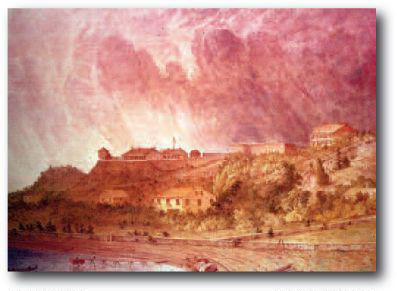
Chapter 10:
The Attempt to Retake Mackinac Island

Twenty-nine days after war was declared on July 17, 1812, Mackinac Island was captured by the British. The Island was the crossroads of the North Country and the American fur industry depended on it. The Americans were very determined to get it back.
Pressured by American fur mogul and naval sponsor John Jacob Astor, the Secretary of the Navy commanded Commodore Isaac Chauncey to order Commodore Perry to retake Mackinac and St. Joseph Island. Flush with two great American victories at the Battle of Lake Erie and The Thames, Perry’s squadron set sail on June 20, 1814. Lieutenant Colonel George Croghan commanded the 2nd Regt. of Riflemen and the flotilla and its Marines were commanded by Commodore Arthur Sinclair.
After three raids on the way to the island, the American officers were stymied as to how to take the awesome British Fort Mackinac situated on a 250-foot limestone cliff. Because of this height, Sinclair knew his ship’s cannon were useless against the fort. The Americans decided to attack the fort from the northwest side of the island, the same landing place the British had used two years earlier. They would have to fight their way through two miles of heavy, Indian-infested woods.
The British, knowing an attack was imminent, had recently reinforced the fort with two companies of the experienced Royal Newfoundland Fencibles and a small detachment of the Royal Regt. of Artillery consisting of one 6-pounder and one 3-pounder cannon. With Lewis Crawford’s 50 militia and 350 Indians, the British totaled 550 men.
On the morning of August 4, five American vessels anchored 300 yards offshore on the northwest side of the island and opened up with a tremendous barrage to sweep the landing place. Five companies (500 men) of American regiments, detached from the 17th, 19th, and 24th Regiments of Infantry, hit the beach first. Colonel William Cotgreave led 250 Ohio Volunteer Militia and a detachment of the Corps of Artillery bringing up several 6-pounder cannon. Marine Lt. Hyde led his detachment of Marines ashore to serve as a reserve.
After the bombardment, the American force of 850 men set out on a narrow track through the woods towards Dousman’s farm. Both the Americans and the British had chosen to fortify the farm since it was the only clearing in the heavy woods and underbrush. As it was, the clearing was only about 500 yards square. British commander Lieutenant Colonel Robert McDouall fortified the southern end of the clearing with abatis of fallen trees. His plan was to fire a volley and then follow with a bayonet charge against the American line. The Indians on both flanks were positioned so the Americans couldn’t outflank the redcoats.
As soon as Croghan’s men reached the north end of the field, they came under artillery fire from the two British cannon. The Americans started to advance but soon realized that advancing on the open field under rapid canister shot would be suicidal. They began encircling on both flanks with the main thrust on the left. Suddenly a band of Menominee Indians—led by chiefs Tomah, Yellow Dog and L’Espagnol—opened fire on the American column, killing Maj. Holmes, severely wounding Capt. Robert Desha and downing a number of his troops.
The Americans panicked, thinking they were surrounded in the heavy woods. They retreated to their main position, then moved forward again towards the center of the British line—but the fight had gone out of them. A retreat was ordered back to the cover of the ships’ guns and the Marines acted as the rear guard. Only one Marine, Sergeant James Tull, was wounded.
The Americans lost Maj. Holmes and ten privates killed while three officers and 50 men were wounded. Two more privates were missing and Capt. Isaac Van Home, Jr., Lt. Hezekiah Jackson, and four enlisted men would later die of their wounds. Under a flag of truce, the body of Maj. Holmes was recovered and returned to Detroit for burial. The enlisted men’s remains, though severely mutilated by the Indians, were buried on the battlefield. The most serious loss to the British was Wee-kah, a Menominee chief.
The American fleet withdrew to Thunder Bay where a squadron set out for Nottawasaga Bay where they destroyed a small British supply base along with the British schooner Nancy.
Mackinac post would be held by the British until July, 1815, when by the Treaty of Ghent, it was returned along with the Michigan Territory—including northern Michigan and Wisconsin—to the United States.

Fort Mackinac
Artist: Seth Eastman